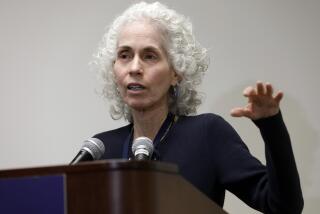Give Health Chief Options
When Los Angeles County supervisors decided last month to close 11 public health clinics and an Antelope Valley hospital, low-income patients told heartbreaking stories about having to travel 50 miles or more to get care for serious diseases. Doctors, nurses and union representatives warned of disease outbreaks and ever more crowded emergency rooms. But no one offered a realistic alternative for easing the county Department of Health Services’ looming $800-million deficit.
With two federal bailouts behind them, the county supervisors know they lack credibility when it comes to asking for help. Looking back to 1995, the last time the health department faced collapse, you’ll see that many of the problems existing then still have not been fixed--among them computers that don’t talk with each other and department officials who don’t talk with each other.
In part because the department’s situation is so hopeless, there finally are hopeful signs that the supervisors will give newly hired health chief Thomas Garthwaite the backing he needs to fix what’s broken. The board agrees, for example, to a major reorganization that will concentrate transplants and other specialized treatments at County-USC Hospital, a practice that should improve patient care but upsets the balance of power among hospitals in different districts. But even the best of managers cannot single-handedly fix the even bigger problem, one the entire nation is pretending doesn’t exist: How are millions of people who don’t have medical insurance supposed to pay for care?
An estimated 2 million L.A. County residents lack insurance, more than the entire populations of 15 states. They are not freeloaders but the working poor. Eighty percent of the 800,000 patients treated each year at county clinics and hospitals work at low-paying jobs that don’t offer insurance. They don’t qualify for public programs like Medi-Cal. Without county hospitals and health clinics, their only safety net would be hospital emergency rooms. And emergency rooms, public and private, are already so overwhelmed and underfunded that they’re turning away even patients with insurance.
The federal bailouts encouraged treatment at cost-efficient primary-care clinics rather than at costly hospitals. Once the aid package runs out in 2005, the federal government will go back to reimbursing the county for hospital stays but not for preventive and primary care. The Bush administration supports giving states flexibility in spending federal money. California’s government leaders must convince U.S. Health and Human Services Secretary Tommy G. Thompson, who as governor of Wisconsin favored local innovation, to give L.A. County the money and flexibility it needs to keep the doors open--after it proves it can be innovative and flexible itself.
More to Read
Sign up for Essential California
The most important California stories and recommendations in your inbox every morning.
You may occasionally receive promotional content from the Los Angeles Times.










